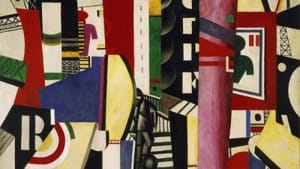Stay in the Loop
BSR publishes on a weekly schedule, with an email newsletter every Wednesday and Thursday morning. There’s no paywall, and subscribing is always free.
Greater than the sum of his parts:
How I learned to love Fernand Léger
‘Léger and the Metropolis’ at the Art Museum (1st review)

The Art Museum’s “Modern Art and the Metropolis” is easy to like and hard to love. It’s apparent, from the first step into this vast exhibit, that Fernand Léger is a colorful brainiac. The degree to which his imagination uplifts the viewer determines whether “like” will turn to “love.”
Léger sought to interpret what Robert Hughes called “The Mechanical Paradise.” Ordered circulation, of forms and energy, are built into Léger’s pictures. So are tightly ratcheted harmonies. At first glance it’s almost too slick.
Countering Léger’s technical brilliance is the soundtrack of his collaborative film, Ballet Mécanique, which fills the air of this exhibit with a kind of sonic smoke. This pounding, percussive music asserts an amorphous dread— an ugly dissonance— that Léger’s paintings lack, even with their heavy black lines.
Elated by war?
This disturbing music reflects the dark side of progress. It’s an aspect of modernity that Léger certainly knew firsthand as a soldier in World War I. But he emerged from the world’s first mechanized war not with battle fatigue but with a zest for self-renewal in Paris.
“I was stunned by the sight of the breech of a 75 millimeter in the sunlight,” he famously remarked. “It was the magic of light on the white metal.” This elation is either miraculous or slightly insane
Either way, it’s pivotal. It must be considered when looking at Léger’s paintings, with their brilliant powers of analysis, devoid of Lost Generation funk. Then, maybe, the viewer can be uplifted by Léger’s miraculous, insane or heroic optimism.
My love test
I’m a viewer who needs a narrative to jump-start his sympathy. Then, having been primed like a school kid, I proceed to the love test: Is there a crisis or dare in the painter’s body of work?
The good news is that I represent the middle of the market as an art consumer. The bad news is that I found Léger hardly accessible on a gut level, and the Art Museum’s infomatics don’t help.
The audio guides lack heart— the very key to melting Léger’s iced stature as a remote “Great.” So regardless of Léger’s narrative as a Normandy kid who left the farm for Paris and survived the First World War, I remained wary.
A materialist?
Léger’s work abounded in crisis and dare but was devoid of resolution or tonic. I felt revulsion because Léger, who triumphantly rejected funk, had surrendered to pure mechanics. “He’s a damned materialist,” I found myself thinking. “What he needs, as a just return for his conceit, are robots viewing his work.”
Since I was wary of my initial disdainful reaction, I stuck around. I sampled Léger’s work on stage and movie sets. I looked at his Cubist, Tubist and late-life paintings. I even read about the rarefied society of artists with whom he chummed in Paris between the wars. But not having been struck by a single masterpiece, I sat down and looked around.
Thanks to this panorama of Léger’s work before my eyes, I began to understand him as a painter whose whole is greater than the sum of his parts, and found myself liking him more by the minute. Now he struck me as a protean talent on a grand scale.
Lover’s quarrel
Only at a distance— where I could take the wide view of the exhibition— did Léger begin to convert me. I finally began to feel, on a gut level, the rhythm of his lines and the vibrancy of his colors.
I found myself rising to Léger’s level of thinking. I put Léger’s abstractions into my own personal frame. Here is a painter, I thought, who engaged in a continuing lover’s quarrel between line and color— a committed struggle between brain and heart.
Then came the big uplift that an art lover can get only at a grand museum. I began to sense a timeless spat across the historical arc of painting— a mad feud between matter drawn with a compass and ruler, and spirit painted with a magic brush.
Likeability problem
Léger’s primary genius, I saw, was to condense the volatility of the creative process. His secondary genius was to condense the volatility of the Machine Age.
The insight made me dizzy. Then I blushed with love.
Léger presents the artist’s struggle with a gentleman’s reserve and a dash of wit. He’s immediately accessible as a colorful brainiac. One can see, right away, why he’s called the father of Pop Art. Oddly enough, it’s his very likeability that makes his greatness so difficult to grasp.
To read another reviw by Michael Lawrence, click here.
To read a review of Léger's Ballet Mécanique by Steve Cohen, click here.
What, When, Where
“Léger: Modern Art and the Metropolis.” Through January 5, 2014 at Philadelphia Museum of Art, Benj. Franklin Pkwy. & 26th St. (215) 763-8100 or www.philamuseum.org/exhibitions/766.html.
Sign up for our newsletter
All of the week's new articles, all in one place. Sign up for the free weekly BSR newsletters, and don't miss a conversation.